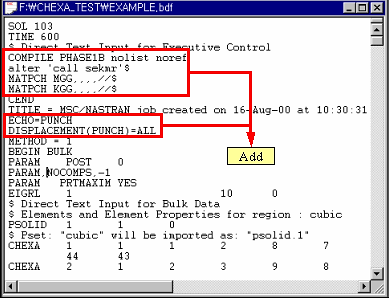10.2.3.3. DMAP Command
10.2.3.3.1. DMAP for Modal Analysis (*.op2)
This is the guide for the Modal analysis (Normal mode analysis) in MSC(or NX)/Nastran. It is necessary for you to the appreciate DMAP command in order to run your input file for Nastran. This example file is located in <Install Dir>\Toolkits\Flexible input files\NASTRAN\NASTRAN_normal_OP2.dat.
Delete
Delete commands related to the super elements
SEALL = ALL SUPER = ALL
Add or Modify
Global Mass and Stiffness Matrix
COMPILE PHASE1B nolist noref Alter ‘call sekmr’$ OUTPUT2 MGG,KGG//0/12////$
Stress and Strain Shape
The below commands are to create the stress and strain shape data to the OP2 file.
Note
If the stress and strain shape is added when you create the RFI file, you should use the Stress/Strain Shape option in Interface Option. (Refer to Interface Options)
… Compile sedrcvr$ nolist Alter 'call gpstress'(2,0) $ OUTPUT2 ogstr1//0/12///$ CEND …
… GPSTRESS(PUNCH)=ALL GPSTRAIN(PUNCH)=ALL …
… VECTOR(SORT1,REAL)=ALL SPCFORCES(SORT1,REAL)=ALL STRESS=ALL STRAIN=ALL $ OUTPUT(POST) $ Set 6 : write all element ids for $ output gpstress and gpstrain (element IDs 1 ~ 50) SET 6=1 THRU 50 $ $$ Solid element : Use VOLUME instead of SURFACE $VOLUME 1 SET 6,DIRECT,SYSTEM CORD 0 $ $ Shell type element : Use SURFACE instead of VOLUME SURFACE 1 SET 6,FIBRE ALL,SYSTEM CORD 0 …
The first box is to write the strain shape data in the OP2 file.
The second box is to write the stress and strain shape in the Punch file and OP2 file
The third box is the necessary command for GPSTRESS and GPSTRAIN.
Note
10.2.3.3.2. DMAP for Modal Analysis (*.pch)
This is the guide for the Modal analysis in MSC (or NX)/NASTRAN. It is necessary for you to the appreciate DMAP command in order to run your input file in MSC (or NX)/ NASTRAN. The below step informs to you how to modify DMAP command. The example file is located in <Install Dir>\Toolkits\Flexible input files\NASTRANNASTRAN_normal.dat.
Delete
Delete commands related to the super elements
SEALL = ALL
Delete unnecessary commands in the case control section.
ECHO = NONE MAXLINES = 999999999 $ Direct Text Input for Global Case Control Data SUBCASE 1 $ Subcase name : Default

Figure 10.62 DMAP command (Delete)
Add
Input Global mass and stiffness matrix
COMPILE PHASE18 nolist noref Alter ‘call sekmr’$
Add the following commands in the case control section.
ECHO = PUNCH

Figure 10.63 DMAP command (Add)
10.2.3.3.3. DMAP for CMS Analysis (*.out)
This is the guide for CMS analysis in MSC/NASTRAN. It is necessary for you to appreciate DMAP command in order to run your input file in MSC/NASTRAN. The steps below inform you how to modify DMAP command. The two example files with this DMAP command are included in the folder, <Install Dir>\Toolkits\Flexible input files\NASTRAN\NASTRAN_scm.dat.
Output File Name
Input a name of output file.
$============================================$ $===== COPYRIGHT (C) 2005 ====$ $===== BY FUNCTION BAY INC. ====$ $===== ALL RIGHTS RESERVED ====$ $============================================$ $ $ DMAP Command for RD/Flex 6.0 $ ASSIGN OUTPUT2='Plate_cms.out' STATUS=UNKNOWN UNIT=20 FORM=UNFORM
Executive Control
Define solution type.
Include ALT file, which makes output file written in the form for RecurDyn.
$--------------------------------------------$ $ EXECUTIVE CONTROL $--------------------------------------------$ SOL 103 TIME 3000 $ INCLUDE 'RecurDyn_rfi.alt'
Case Control
Define ‘SUPER’ and ‘SEALL’ for Superelemnet
Define GPSTRESS and GPSTRAIN for Stress and Strain Shape
$--------------------------------------------$ $ CASE CONTROL $--------------------------------------------$ TITLE= CMS analysis for RecurDyn SUBTITLE= Plate model $ ECHO = PUNCH METHOD=2 $ SUPER=1 SEALL=1 GPSTRESS(PUNCH)=ALL GPSTRAIN(PUNCH)=ALL SPC = 1 METHOD = 1 $ VECTOR(SORT1,REAL)=ALL SPCFORCES(SORT1,REAL)=ALL STRESS=ALL STRAIN=ALL $ OUTPUT(POST) $ Set 6 : write all element ids for output gpstress and gpstrain (element IDs 1 ~ 50) SET 6=1 THRU 100 $ $$ Solid element : Use VOLUME instead of SURFACE $VOLUME 1 SET 6,DIRECT,SYSTEM CORD 0 $ $ Shell type element : Use SURFACE instead of VOLUME SURFACE 1 SET 6,FIBRE ALL,SYSTEM CORD 0
Bulk Data
Set Parameters.
Specify interior grids except interface nodes.
Release some degree of freedoms of interface nodes.
Define data needed to perform real eigenvalue analysis with the Lanczos method.
Define scalar points.
All scalar point identification numbers must be unique with respect to all other structural, scalar points.
The number of spoints (Scalar Points) is equal to the sum of normal modes and residual vectors.